| In the mid 1920s Guy introduced an ambulance, based on the
one ton 'JA' chassis, with special springs and shock absorbers.
The body was built in the body shop, and could accommodate 4
sitting patients, and two stretchers. |

A Guy ambulance.
|
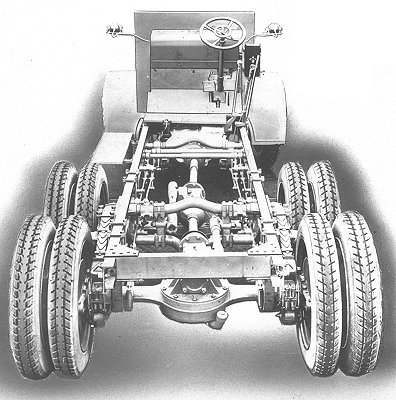
A Guy rigid 6-wheeled chassis. |
Guy continued to develop cross country
vehicles for military use, and in 1926 began to produce a rigid
6-wheeled chassis with 4 rear wheels mounted on a rocking
cross-shaft, to form a bogie, which allowed a large amount of
articulation.
The rear wheels could be fitted with chains
so that the vehicle could successfully be used under the most
difficult conditions.
The vehicles were supplied in many forms,
including general service army wagons, artillery tractors, field
workshops, and searchlight generators. |
| |
|
| Read about the Guy rigid frame,
six-wheeled chassis |
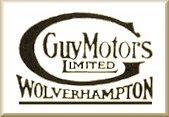 |
| |
|
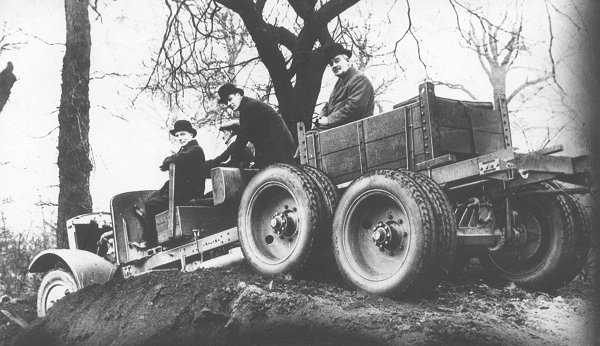
A 6-wheeled chassis on test.
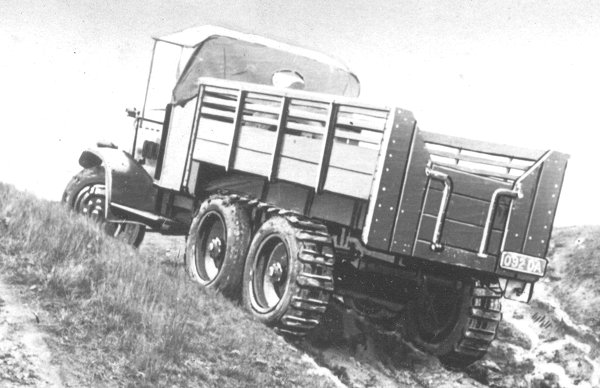
A 6-wheeled lorry fitted with chains on
the rear wheels.
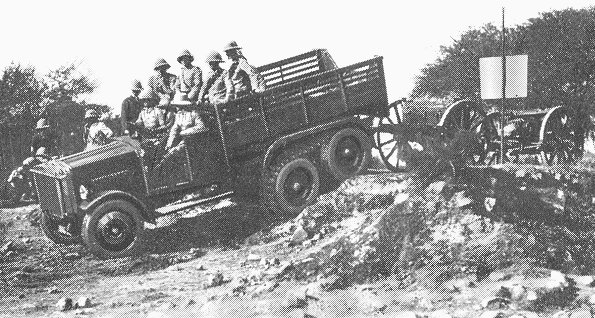
One of the 6-wheeled gun tractors
supplied to the Indian government.
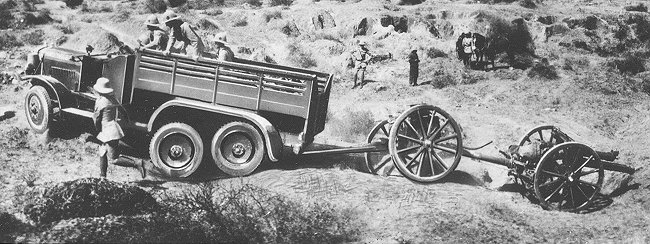
Another view of a gun tractor.
|
In 1926 much of the country’s industry was
brought to a standstill by the general strike, which lasted for
10 days, from the 3rd of May until the 13th of May. It was
called by the TUC in an unsuccessful attempt to protect coal
miner’s wages and working conditions.
Many companies were badly affected by the
strike, but luckily at Guy Motors only a few employees came out
on strike, due to the excellent industrial relations at the
factory.
After the strike, Sydney Guy formed a works
committee to liaise with employees and management in a case of
dispute. All employees had to sign a declaration stating that
they would follow a standard procedure, and would not undertake
any industrial action until the procedure had been completed.
They agreed to notify the works committee in writing, about any
dispute, and the works committee in turn, had to discuss the
matter with management, and reply in writing within 48 hours. If
the reply was unsatisfactory, the works committee could then
refer the matter to the relevant trade union representative, who
could communicate with the managing director. The system worked
extremely well, and Guys remained strike free.
During the same year, the company produced
Europe's first 6-wheeled buses, and the world’s first 6-wheeled double decker trolley buses, which
were supplied to Wolverhampton Corporation. They were the first
of the large number of Guy trolley buses which would be built during the next
36 years, and supplied to operators both in the UK and abroad..
In March, 1927 Jack Bean joined the Board
of Guy Motors. He had previously been Managing Director of Bean
Cars Limited at Tipton.
Another Guy innovation appeared in 1927.
Petrol supplies were few and far between in many remote parts of
the world, and so the company developed the Guy gas producer, a
vehicle that burnt charcoal. 18 lbs of charcoal would do the
same work as 1 gallon of petrol, and was far cheaper. The
vehicles were supplied to many customers, including the Crown
Agents for the colonies, the Empire Cotton Growing Corporation,
and the Australian government. |
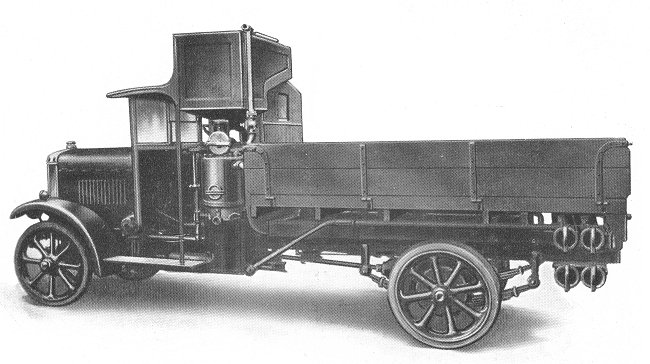
A Guy gas producer.
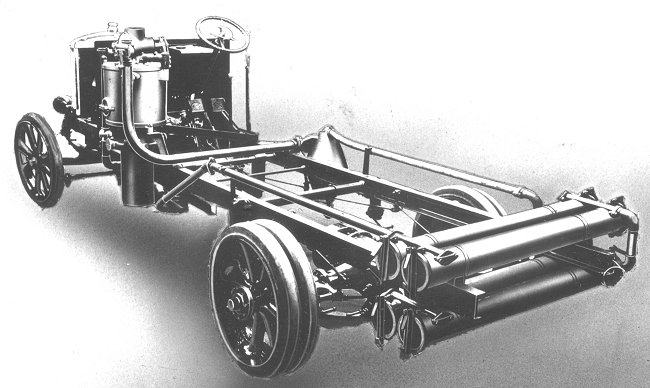
The gas producer chassis.
| |
|
|
|
|
Read an article
about the Guy
gas
producer
chassis |
 |
|
Read about the
test of a Guy gas producer in
Australia |
 |
| |
|
|
|
|

A final view of a gas producer lorry.
| One of the fleet of Guy 6-wheeled
buses using the drop-frame chassis, which was sold to the London
Public Omnibus Company in 1927.
They were the first 6-wheeled buses to operate in the capital,
and were a great success. |
 |
|
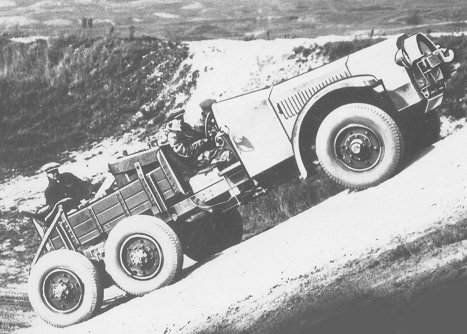
A prototype armoured car chassis on test under full
load. |
Until the 1940s, armoured cars were usually based on large
touring car chassis. In the mid 1920s Guy developed an
armoured car based on the 6-wheeled commercial vehicle chassis,
to produce a robust, go anywhere design.
The vehicle weighed 9 tons, and had a circular blower-type
radiator, and a top speed of 45 mph.
In 1928 over 100 of them were supplied to the Indian
government. |
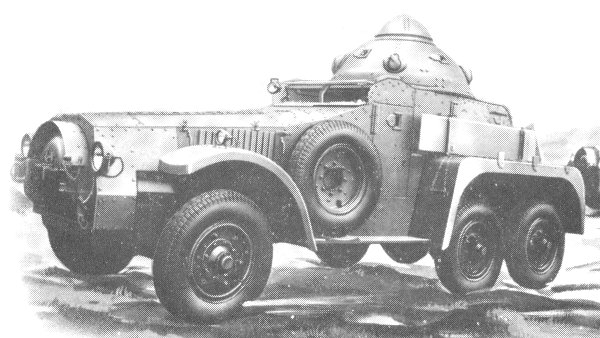
A Guy armoured car.
| |
|
| Read about one of the oldest Guy
lorries that is still in use |
 |
| |
|
| By the late 1920s the Star Engineering Company Limited of
Wolverhampton found itself in trouble because of falling sales.
The company produced a small range of commercial vehicles, and
high quality cars. In 1928 with production still falling, Star
found itself in a precarious financial state. As a result Guy
Motors took control through an exchange of shares, though Star
continued in existence as a separate company, now called The
Star Motor Company Limited. |
| In 1927 Star launched a new
commercial vehicle chassis called the 'Flyer' which was
developed from a 20-seater low-loading bus chassis. It was
powered by a 3.2litre 6-cylinder engine, and sold for £645. When Sydney Guy decided to take the company over, he either
had his eye on the 'Flyer', or wanted to re-enter the high
quality car market. Most of Star's production took place in a
number of factories in the Frederick Street area of
Wolverhampton.
The company also had a new factory in Showell
Lane, Bushbury, where bodies were built. In 1929 all of the
factories around Frederick Street were closed, and production
moved to Showell Lane where cars could be built under one roof.
The workforce was reduced to around 250, and Guy dropped some of
Star’s heavier commercial vehicles that were in direct
competition with its own products.
|

An advert from 1929. |
|
Three cars were available, the 18/50, the 20/60, the
occasional 24/70, all with a range of bodies, and a 1¾
ton version of the 'Flyer' with vacuum brakes. Under Guy,
Star cars retained their quality build and high levels of
workmanship, but they were far too expensive for most people,
particularly in a time of recession. 1930 saw the introduction
of the ‘Comet’, ‘Planet’ and ‘Jason’ series of cars. Around 214
cars were produced that year, the most popular being the
18/50hp. ‘Jason’, selling for £595.
 |
A 1930 Star 'Comet'. |
Unfortunately a small loss was made on the sale of every
vehicle. At the time, Guy Motors was also in financial
difficulties due to the recession, and so couldn't afford to
equip the new Bushbury factory with up-to-date machinery.
Star found itself in a desperate situation, and as a result a
receiver was appointed in March 1932.
Spares and manufacturing rights were obtained by McKenzie and
Denley, of Birmingham, who continued selling spares and
servicing Stars into the 1960s. The Frederick Street works were
sold to James Gibbons (Windows) Limited, and later to Chadd
Castings Limited, who cast aluminium components. The Bushbury
factory was sold to Manley & Regulus, makers of plumbing
fittings, and later acquired by Delta Metals.
The end of the 1920s was a difficult time for Guy. Between
1925 and 1929 profits greatly increased, but during the
recession following the Wall Street crash in October 1929, Guy
shares fell from one pound to just one shilling. Shareholders
lost 95% of their investment in the company, which was caused by
the recession, and the purchase of ailing Star. The company came
close to collapse, and must have deeply
regretted taking over Star. |
|

A fine example of a Guy vehicle used for
mobile publicity. |
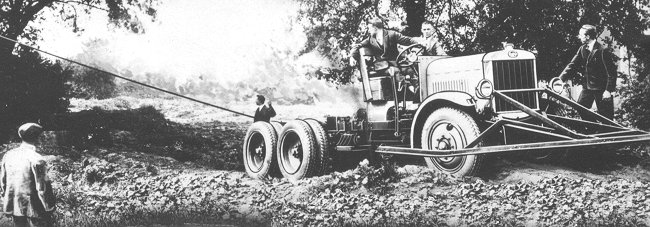
An unusual application for the 6-wheeled
chassis was the Tsetse fly exterminator vehicle that could
uproot trees and clear vegetation with the cutter at the front. |
|
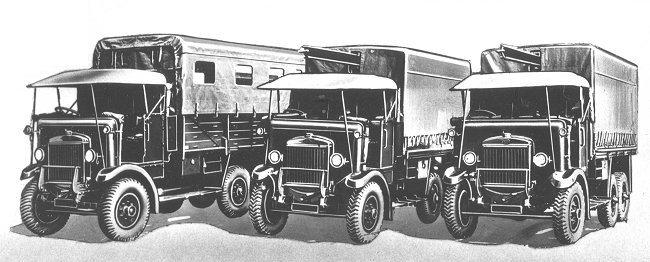
Part of a large fleet of 6-wheeled Guys. |
 |
|
 |
|
 |
Return to
The
Early Inter-War Years |
|
Return
to the
beginning |
|
Proceed to
Into the 1930s |
|